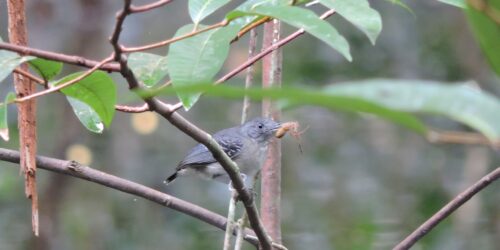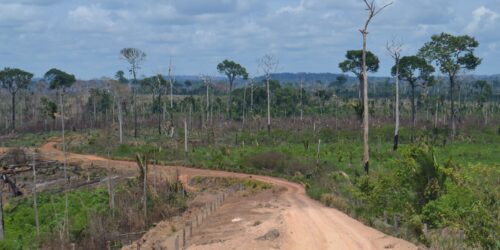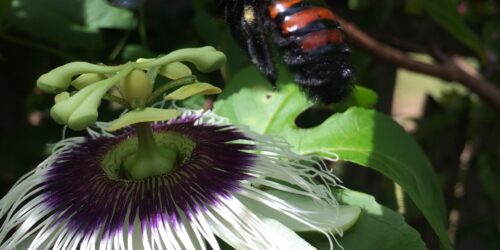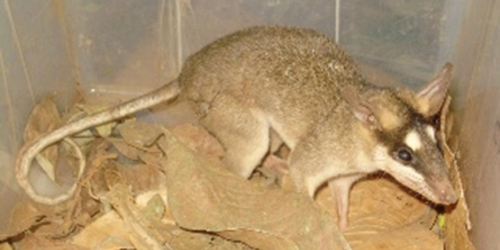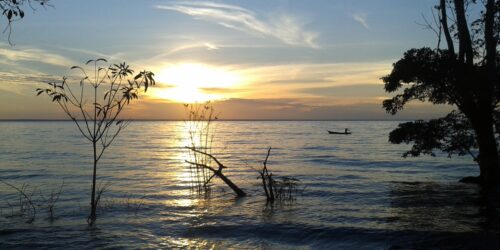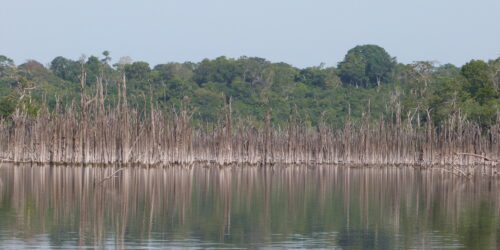Birds of the Amazon floodplains
3 November 2020 | Duration of reading: 8 min
By Bianca Darski
The Amazon - where nature is extremely rich, where everything that is planted is harvested, where the trees and water are abundant - it is without doubt the biome of superlatives. The rainfall dynamics in Amazon is strongly linked to biological diversity patterns that characterize this biome. This stems from the combination of high rainfall volumes and predominantly flat terrain in the Amazon basin. The result of this combination is a landscape drawn by large rivers - as Amazon, Madeira and Tapajós rivers - that separate or connect (depending on the organism!) regions in the Amazon.
The lowlands surrounding the large amazonian rivers are called floodplains (locally known, in Portuguese, as "várzea" or "igapó"). The floodplains are so called on the account of rivers overflow, a process that may last for months affecting every being living there. Unflooded areas are situated on higher grounds and are called "terra firme". Many studies evidence the existence of a consistent pattern in the geographic distribution of bird species in terra firme due to great rivers that act as barriers, causing the dispersion of several species - and not only of birds.
The areas between the large amazonian rivers are called interfluves and in these locations there is a concentration of endemic species, in other words, species only found in these areas (know more about endemism areas here). However, little is known about the distribution patterns of bird species that inhabit floodplains, a theme that got more attention from ecology, zoology and genetics researchers in the last decade.

Madeira river floodplains near Porto Velho city, Rondônia, Brazil. Photo: Bianca Darski
Differently from species inhabiting terra firme regions there is not a clear endemism pattern for species of the Amazon floodplains. Nevertheless, it is possible to notice that floodplains (várzeas and igapós) are not homogeneous across the Amazon basin, since they are divided in at least four ecoregions. According to WWF, an ecoregion is “a large unit of land or water containing a geographically distinct assemblage of species, natural communities, and environmental conditions”. The terra firme ecoregions limits coincide with the endemism area limits (see here) and, therefore, are complementary concepts.
We undertook a study in the floodplains (várzeas) of the second largest amazonian river, the Madeira river, with the objective to analyse the diversity and occurrence patterns of bird species in different locations of the amazon floodplains. We went through about 800 km from Porto Velho, Rondônia state - a distance that corresponds to the middle portion of Madeira river to its mouth, where it meets the Amazon river.
We registered 402 bird species in the Madeira river floodplains environments. More than half of these species (56,7%) are typical of flooded environments and 43,3% are commonly registered in unflooded environments, but also inhabit floodplains, specially in dry seasons.

Black-and-white antbird, whose scientific name is Myrmochanes hemileucus (Sclater & Salvin, 1866), is a bird species that inhabits exclusively river islands of the Amazon basin. Photo: Bianca Darski.
Our results revealed no difference in bird species diversity between the Madeira river banks, which can have 10 km of distance in extreme flooding seasons. On the other hand, our results indicate that bird species along the river are not the same, thereby there is a species substitution from the middle portion of Madeira river to its mouth. Furthermore, birds observed in the river islands are considerably distinct from the ones observed along the banks. These species, as the black-and-white antbird (Myrmochanes hemileucus) and the white-bellied spinetail [Mazaria (Synallaxis) propinqua], are examples of birds that depend on river islands systems.
Our research highlights the high bird diversity in Madeira river floodplains and indicates that spatial distribution patterns of these species is related to the altitude gradient. Moreover, reinforces the value of floodplains in the maintenance of an important portion of the Amazon bird biodiversity. The conservation of this huge biodiversity depends on the preservation of these environments' natural characteristics.

White-bellied spinetail, whose scientific name is Mazaria (Synallaxis) propinqua (Pelzeln, 1859), is a bird species that inhabits exclusively river islands of the Amazon basin. Photo: Bianca Darski.
Science is done collaboratively
The results here shown are a part of a master’s research by Bianca Darski in the Program of Post-graduation in Zoology, in the Paraense Museum Emílio Goeldi in partnership with Federal University of Pará. Advised by Marco Pérsio and co-advised by Alexandre Aleixo. This research is part of a broader study that was financially supported by the Brazilian federal government through the project “Subsídios para o planejamento de áreas protegidas nas várzeas do rio Madeira” (CNPq Process nº 550331/2010-7), coordinated by Ana Luisa Albernaz of Paraense Museum Emílio Goeldi.
Want to know more? Access the links below!
Borges, S. H., & Carvalhaes, A. (2000). Bird species of black water inundation forests in the Jaú National Park (Amazonas state, Brazil): their contribution to regional species richness. Biodiversity & Conservation, 9(2), 201-214. (Link)
Da Silva, J. M. C. (2012). Áreas de endemismo, corredores de biodiversidade e a conservação da Amazônia. In: Conservação da Biodiversidade em paisagens antropizadas do Brasil, capítulo 22. Editora UFPR. (Link)
Remsen Jr, J. V., & Parker III, T. A. (1983). Contribution of river-created habitats to bird species richness in Amazonia. Biotropica, 223-231. (Link)
Ribas, C. C., & Aleixo, A. (2019). Diversity and evolution of Amazonian birds: implications for conservation and biogeography. Anais da Academia Brasileira de Ciências, 91. (Link)
Silva, Bianca Darski. Padrão de distribuição de assembleias de aves nas florestas de várzea do rio Madeira. (2014). Dissertação de Mestrado. Universidade Federal do Pará, Museu Paraense Emílio Goeldi, Belém. Programa de Pós-Graduação em Zoologia. (Link)

Bianca Darski is a biologist (UFRGS), a master in zoology (MPEG / UFPA) and a doctor in ecology (UFRGS). See more on Lattes and ResearchGate.

